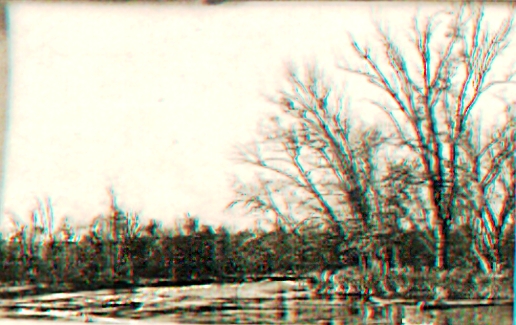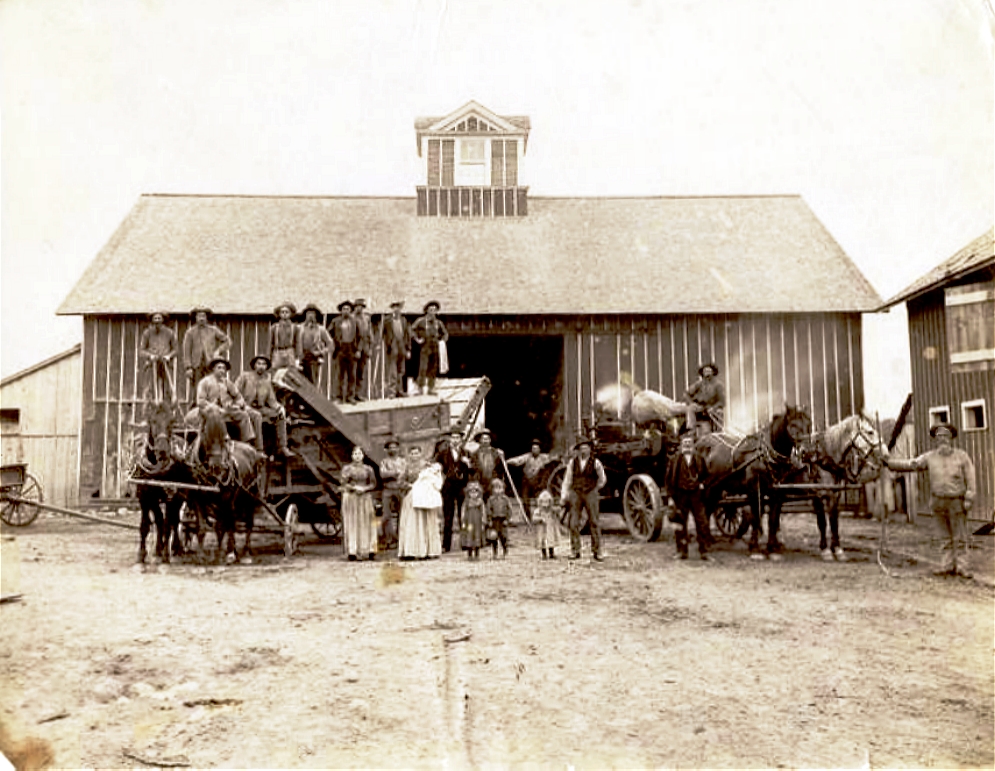
Ehlinger
Threshing Machine and Crew.
1913
This
steam threshing
rig owned by Michael Ehlinger was the first to be used in How township
and had been put to hard work for many years by the time this photo was
taken.
The first threshing machine with separator was brought to Oconto County
in 1859.
|

Commemorating
the
first metal
bridge over the Oconto River at that spot.
Most of the people on the photograph
are the construction crew (left side) and Town Board of the Town of
How.
Herman Yakel, Robert Grignon and Robert Johnson (later to become
Wisconsin
State Treasurer) are among the people on the picture. The bridge was
just
west of Suring, c:1910 and replaced a series wooden ones. |

Oconto River
Flood of 1912
Although there were several major
Oconto River floods in the last 150 years, the worst for local
residents
was in 1912. In this photo, taken from a boat the day after torrential
rains ended, show a faint original shoreline just in front of the
center
clump of trees. The waters go back as far as the eye can see, causing
tremendous
damage to buildings, equipment and livestock. |

Oconto River in
Town of How
This very early photograph of the
river shows the original natural state, with mashes, cedar swamps and
low
wetlands. Fish and game were abundant to the Native Americans living
along
it's banks, probably for several thousand years. Canadian fur traders
were
the first settlers, brought by the European market for fine pelts. In
the
background stands the dense pine forests that brought the timber men
from
the east, starting in 1823. Once logged, the land was soon occupied by
farm families and town of How became a successful part of dairy farming
in Wisconsin. |

Making Hay in
Town of How
Farmers worked together to bring
in the produce. Here it is hay for winter. All the men and boys in
neighboring
families would work each other's fields together, moving from one farm
to another, dawn to dusk, with a milking break.. Women and girls often
joined in, but more often were busy preparing the noon and dinner meals
which were served outside on long tables made of wood planks on saw
horses.
Each family was expected to serve large meals when the crews came.
Women
often helped each other in the tremendous effort it took to make and
serve
hams, piles of potatoes, home baked breads, butter, baked beans, salads
and other filling foods.. |

Oconto River in
Town of How
Trout Fishing
Fishing in the Oconto River was
well known long before any settlers arrived as the Native Americans
built
rock fish traps along the shoreline for hundreds of years.. In town of
How it was a favorite pastime. There was no status to fishing the
river,
anyone with even the most basic of equipment and a little free time
could
participate. Here is a fly caster from years back. Even owners of major
railroads would stop along their journeys to wet a line. One wealthy
railroad
baron would have his private steam engine train halt to drop him off
the
moment he saw a likely fishing spot and wait until he was done. But
most
just hiked in through the woods. |

Otradovec
Farm in Town of How
Anton Jr and his wife Maggie
Müller Otradovec are among the family members on the porch of
their
recently built wood frame home c:1900. Note the log barn to the left
rear,
canary cage hanging on the porch, pet pug dog and "coon" hound hunting
dog, and the garden that comes right up to the porch. The Otradovecs
were
reprsentative of the Bohemian families to settle in town of How. Maggie
Müller was from among the many Rheinlanders to immigrate in
the 1880s.
|

Barn Raising in
Town of How
This c:1898 photo is taken from
an interesting and unusual angle behind the large pile of fieldstone
hauled
in for use with concrete in building the barn foundation. This happy
extended
family gathers just before a Barn Raising. The wooden framing has been
completed. Now family, friends and neighbors will come to finish the
outer
sheathing all in one day. There will be a pot luck dinner for all with
dishes brought to pass once the work is done. Then the completion of
the
project is celebrated with an evening barn dance for all ages. Music
was
supplied by local people and a "caller" would oversee the square
dances.
This barn still stands in town of How. |

Philippi
Homestead
in Town of How
This c:1894 photograph of the
Matthias and Catherine Brust Philippi family is set in front of their
tidy
log cabin home. Note the log barn (left rear), recently planted trees
and
the tiny bouquet of flowers held by their youngest daughter. The family
dog sleeps at their feet. Shortly after this photo, work began on a
large
victorian home for the family. The land and buildings originally
belonged
to the Grignon family..
|

Henry Johnson
Farm.
Steam
rises from this threshing
rig owned by Michael Ehlinger was the first to be used in the township.
Standing on the separator from left to right: John Hoeffs, Ernest
Schuettpelz,
George Smith, Max Schuettpelz, unidentified man, and Paul Schuettpelz.
Seated are Michael Ehlinger and Fred Luebuck. Standing in front: Betha
Dieck,
unidentified man, Mrs. Henry Johnson (Augusta Dierck), holding baby
Gladys
(born May 1896), L.C. Harvey (in suit), Harvey Armstrong behind the
twins
Lillian and Leonard Johnson, John Overlough, Michael Ehlinger Sr.,
seated
on the steam engine, and Ed Finley holding the team. Henry Johnson is
holding
his son Millard's hand.
|
|
|